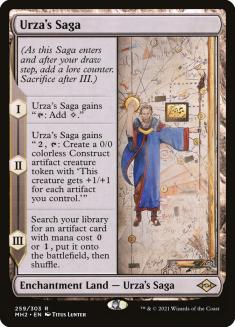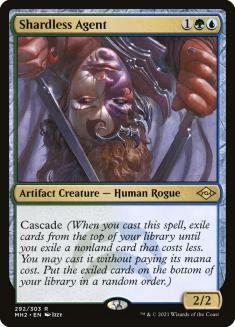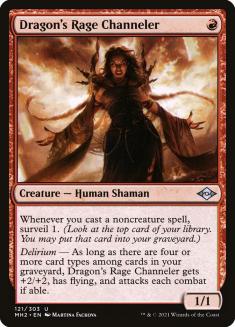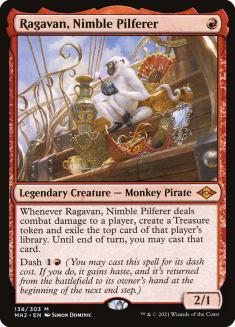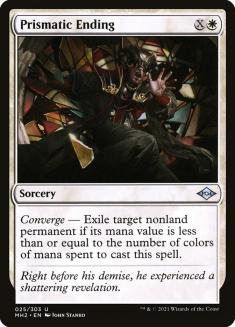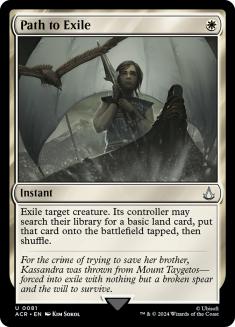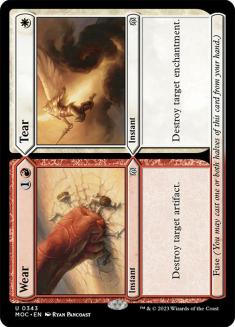I used to hate Modern.
Over the years, Modern has been through some less than ideal iterations. Cards like Hogaak, Arisen Necropolis; Uro, Titan of Nature’s Wrath; and Oko, Thief of Crowns likely caused many folks to lose their faith in Modern. Despite the similarly bad press surrounding Modern Horizons 2, Modern continues to thrive. Aside from the prohibitive cost of some cards and decks, I can’t sing the format’s praises nearly enough.
Yes, Urza’s Saga is… generous. Dragon’s Rage Channeler and Ragavan, Nimble Pilferer form the backbone of countless midrange decks. Was adding Shardless Agent to Modern and giving cascade decks more tools really necessary?
And yet, the format isn’t that much different from when Mox Opal, Ancient Stirrings, and Faithless Looting were squaring off against each other. The big difference is that rather than leaning on artifact, graveyard, or land hate, creatures rule the format again. In the grand scheme of things, it’s an excellent change.
Regardless, Modern has the appeal it always did — you can pick your favorite archetype, tune it week to week, and have a fairly good shot at success. Over the last month-and-a-half, several lessons I’ve encountered in the past have come up. I’ve also learned a few things specifically tailored to this version of Modern. All that knowledge has allowed me to stay on top of the metagame, build some truly excellent decks, and make solid deck choices each week.
1. The Best Plan in Modern Will Always Involve Sidestepping Your Opponent’s Interaction
The first thing to note about Modern is that damage-based removal is warping the format. As soon as players adopted Unholy Heat en masse, Primeval Titan vanished. Tarmogoyf is also absent, but there are other reasons for that. Cards like Murktide Regent, Colossus Hammer, and Sanctifier en-Vec perform well, and making multiple creatures from Crashing Footfalls or Living End leads to viable strategies.
A single caveat is that creatureless control decks aren’t particularly great in most instances because they rely on planeswalkers. Even things like Teferi, Hero of Dominaria can’t stand up to an Unholy Heat without a little bit of help. Those were the decks you used to turn to when people were a little too Jund-happy but it’s trickier now. The old versions of the big control decks now get farmed by the new, smaller midrange decks. More on that later.
Asmor decks were initially all the rage because of how much they punished creature decks and how difficult they were to attack. For a while, it looked like they couldn’t be stopped. Eventually, people figured out sideboard plans that worked and decks that smashed it and it mostly faded away. Maybe there’s a better way to sidestep, but it hasn’t been found quite yet.
Given that Mono-White Hammer is still doing great, I can’t imagine those Shattering Sprees disappearing from people’s sideboards for a while. When they do, you will see Asmor rise up again. Asmor isn’t a bad deck or strategy; it’s simply bad right now. They couldn’t adapt, so they faded away instead. Sometimes, the best way to sidestep what your opponent is bringing to the table is by switching decks entirely.
2. “Better” Doesn’t Mean Strictly Better
Prismatic Ending has also seen widespread play, both as a one-mana removal spell against Ragavan and DRC, but also as a way to remove random permanents like Wrenn and Six and Colossus Hammer. In theory, it seems great, but there are situations where Path to Exile is still stronger. I’d wager that much of the power of Murktide Regent is tied up in the fact that people refuse to play cards that actually kill it. To a certain extent, the same could be said of Colossus Hammer.
Ironically, as players quickly adapt to Unholy Heat, they ride the hype around Prismatic Ending, which makes them more vulnerable to the cards Unholy Heat doesn’t kill. There are instances where Prismatic Ending is much better than Path to Exile, like when you’re playing four Chalice of the Void. However, in the context of the metagame, having the instant-speed answer to anything is worth playing. Maybe you don’t max out on Path to Exile and you should be playing a mix of Path and Prismatic Ending, but I’m skeptical of any deck that chooses to eschew Path entirely.
Be wary of shiny new toys. I dislike Path to Exile more than most and even I recognize its importance at the moment.
3. Prepare for a Range of Decks, Not Just the Most Popular
In general, you should be hedging against the entirety of a format as a whole rather than making a hard read. This tends to be the most common complaint among tournament grinders. They’ll cut their Eldrazi titan, citing Dimir Mill as a ”bad deck” or something that “nobody” plays. In reality, Dimir Mill is a fine deck and one that shows up in the winner’s bracket enough that adding a single Emrakul, the Aeons Torn to your sideboard will gain you more percentage points than it will cost.
Creatures (8)
Planeswalkers (1)
Lands (20)
Spells (31)

At Pro Tour Rivals of Ixalan, I finished second largely on the back of my record with Mardu Pyromancer. My initial decklist came from Mattia Rizzi (who also did well in the Modern Super Qualifier with Grixis, albeit a Death’s Shadow variant). His version solidified some of the issues I had with the deck, and when it came time to tune the last few sideboard slots, I insisted on playing two copies of Wear // Tear.
He was incredulous. “What matchup is that for?” He listed off roughly the top ten decks in the format, none of which I would bring Wear // Tear in against. He wasn’t wrong but Modern has a diverse suite of decks and not everyone copies the best decks. If they did, formats would never shift. Plus, people at Pro Tours are always trying to “break it,” which actually means they trick themselves into playing bad decks.
I mean, we were playing Mardu Pyromancer, so…
My response was that there were cards like Rest in Peace, Chalice of the Void, Leyline of Sanctity, and Leyline of the Void that our deck was not very good against. Lantern Control was also solid, although certainly underplayed. He didn’t think anyone would show up with those cards but I had played enough Modern to know better. Plus, it wasn’t like I needed those sideboard slots for the decks Mattia listed anyway. I’d prefer to have game against the format as a whole, especially when it doesn’t mean sacrificing equity elsewhere.
I played against Eldrazi Tron twice, Ad Nauseam, and Lantern Control in the finals. My tournament would have ended much sooner without having a well-rounded sideboard. If anything, my Wear // Tears were overworked.
Yet another example of this happened recently in the Modern Super Qualifier. A small contingent of good players decided to play a tuned version of Temur Crashcade. Now, none of them won the tournament, but many had deep runs, and it was largely off the back of players not respecting the archetype.
Mono-White Hammer players started cutting their Drannith Magistrates and other players were trimming Chalice of the Void and Engineered Explosives, which meant the time was right to register a Cascade deck.
Now, am I saying play four Sudden Edicts in every deck to beat Bogles? No! However, when a deck like Dimir Mill is 2% of the winner’s metagame, it’s not that much different from Mono-White Hammer being 7% of the winner’s metagame. Both should respect at least some attention. When improving your matchup against Dimir Mill often involves a single sideboard card, you should probably do it, especially if your matchup isn’t particularly good to begin with.
If you take anything away from this article, let it be this lesson. This mentality has shaped my entire career and occasionally cost me when I forgot to follow it. How often do you play a long tournament, especially in Modern, and every single opponent was playing a deck you considered top-tier and specifically prepared for?
Spoiler: It’s rare.
4. There’s Always an Answer to the Best Deck
Amusingly, the most common complaint from Modern players is that Ragavan or Colossus Hammer is too powerful. Izzet Midrange and Mono-White Hammer are the most fundamentally easy decks to beat! They’re straightforward and don’t have a particularly robust backup plan. If Colossus Hammer decks keep winning, it’s because people aren’t trying hard enough.
Asmor faded away amidst all the complaints of it being broken. Rakdos Midrange faded away just as quickly as it came. Colossus Hammer’s results are trending downward. Change is inevitable.
After the format adapted to the Asmor hype, it eventually settled into the most efficient builds of Dragon‘s Rage Channeler decks. Those decks were aggressive, although they tended to fold to a pile of removal. That left the format wide open to decks that could go over the top.
For starters, play a ton of removal. The other part of the equation is having something that can dodge Unholy Heat. Either gain massive card advantage or play something bigger, such as Death’s Shadow. Alternatively, you could do the Murktide Regent thing, although black gives you discard and very impressive cards like Kolaghan’s Command.
My Grixis sideboarding guide included Elementals because the deck was picking up traction. It was well-positioned and I assumed it would continue to gain popularity.
One week later…
Creatures (21)
Planeswalkers (6)
Lands (22)
Spells (11)

In this case, going over the top was the answer to the format. Card advantage, removal, lifegain, and graveyard hate are inherently rolled up into Elementals and it’s the perfect recipe for success in Modern.
To top it off, Elementals isn’t vulnerable to artifact or graveyard hate. It’s creature-based, yet normally plows through interaction with Risen Reef, Ephemerate, and Omnath, Locus of Creation. Overall, Elementals is a beautiful deck choice.
Creatures (4)
Planeswalkers (5)
Lands (24)
Spells (27)

Hall of Famer Gabriel Nassif knows his way around deckbuilding, the Modern format, and control decks, so this result isn’t surprising. Rest in Peace maindeck and Supreme Verdict are two of the best possible things to be doing against Izzet Midrange. They have Expressive Iteration and some counterspells, so they can play a long game, but he wins those with Shark Typhoon.
Notice the sideboard choices. Spreading Seas, Alpine Moon and Crumble to Dust (alongside the maindeck Field of Ruins) give him a shot against big mana decks that would otherwise be poor matchups. Are they popular? No, but he knew that was probably the only type of deck he was going to lose to. Plus, Spreading Seas and Alpine Moon are solid answers to Urza’s Saga, so he’s not sacrificing much.
I almost played the Modern Challenge that Kanister won with a version of Jeskai Control. Unfortunately, waking up at midnight isn’t exactly conducive to playing in these tournaments that are widely catering toward a US-based player base. Oddly enough, my deck was an amalgam of Nassif’s deck and an Azorius Control deck with Chalice of the Void that Kanister played earlier. Both Elementals and control are viable options at the moment, as are things like Five-Color Control with Bring to Light and Scapeshift.
If these bigger decks are the future of Modern, playing slightly bigger creature decks won’t be the answer. Solitude and Supreme Verdict have creatures locked down. Death’s Shadow could be favored against Izzet Midrange, but you don’t want to beat Izzet while losing to the other decks also trying to beat Izzet. It’s something I’m going to explore because I enjoy those strategies, although I’ll be more than willing to jump ship if the metagame trends toward Teferi, Hero of Dominaria.
Stop complaining and start brewing. Solving the puzzle is part of the fun of Magic, so embrace and enjoy it.
5. Normalize Saying “I Don’t Understand”
The week following my Grixis article was a wild ride. I didn’t see anybody pick it up until Daryl Ayers tweeted about how he was crushing with it. From there, it was a mixed bag.
Various people picked up the decklist straight from Daryl’s tweet. They didn’t read the article, so they didn’t ever sideboard out Ragavan as intended, and they didn’t treat it like a control deck. They added Kroxa, Titan of Death’s Hunger, a card that truly accomplished very little. They lost without ever wondering if they were doing something incorrectly. There were people who assumed the deck was bad because it played Snapcaster Mage.
Snapcaster Mage! Can you believe that? Snapcaster Mage is suddenly a card that people think is bad?
I’m honestly confused how we even got to this place. Maybe it’s just the (very) online community trying to label everything they don’t like as “boomer.” Well, I am a Magic boomer, and back in my day, Snapcaster Mage was the best card in every format and for good reason. And guess what? When everyone is playing Lightning Bolts and one-drops, you can beat them by doing the same thing but also playing Snapcaster Mage!
Thankfully, Modern’s largest tournament after Modern Horizons 2 happened last weekend. Given that I assumed most of the Modern community had written off Grixis Control, imagine my surprise when three copies made the Top 8.
I was beyond elated. There were some folks who, despite the naysayers, picked up the deck, learned it, and had success at the highest level possible. More importantly, maybe these tournament results will cause others to reflect on why they dismissed the deck in the first place.
When faced with a massive influx of new cards, perhaps it’s better to reserve judgment until you have all the information. It’s okay to not know everything. We should normalize being able to say “I don’t understand.” Someone asks your opinion or you feel the need to Tweet and you don’t have all the information? Maybe you don’t understand. You finish a League and have medium results? Maybe you don’t understand. Admitting that isn’t an indictment of your skill or knowledge. We’re always learning and should embrace that. The day you stop learning is the day you die.
Modern is Magic’s best format at the moment and it’s not particularly close. Given the way the format has successfully evolved, I think we’re going to escape the second Modern Horizons set without any bannings, which is impressive. Those cards make up the backbone of Modern and isn’t necessarily a bad thing. It’s different, but the same. A curated injection into the format can have positive results, as this latest iteration has shown.
As always, I look forward to future shake-ups, exploring the new strategies and interactions, and learning.


